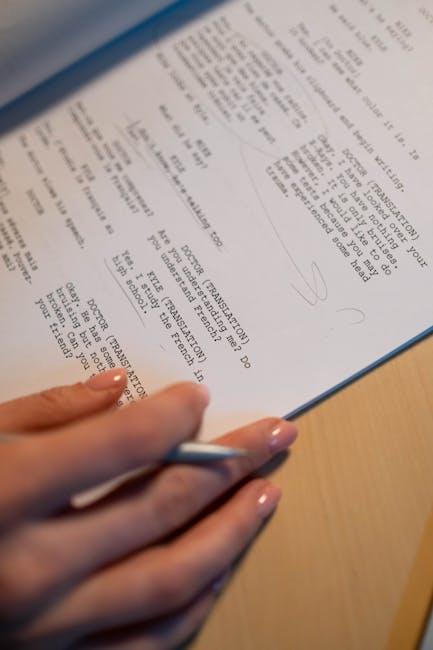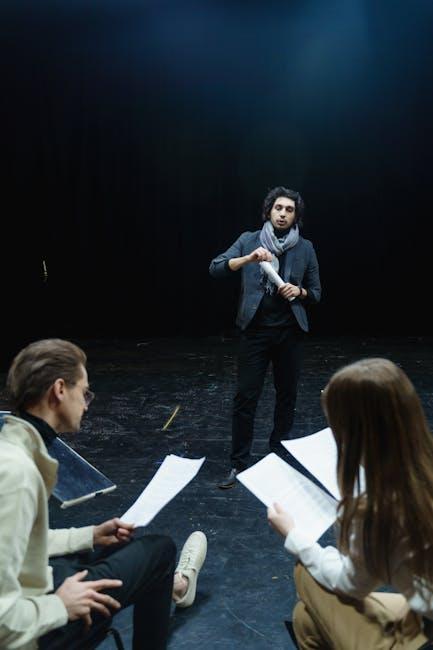In the world of filmmaking, where imagination takes flight and stories come to life, the script is the cornerstone—a blueprint that guides the cinematic journey. Yet, much like a painter revisiting a canvas, the process of rewriting scripts is an art form in itself, a dance of creativity and precision. As directors, writers, and actors delve deeper into the narrative, they discover layers previously unseen, nuances begging to be explored. This article delves into the fascinating realm of script rewrites, unveiling how this transformative process shapes the films we cherish, and highlighting the delicate balance between vision and evolution in the pursuit of cinematic excellence.
Crafting the Perfect Rewrite: Balancing Vision and Practicality
When embarking on the journey of rewriting a script, striking a balance between the original vision and the practical demands of filmmaking is crucial. A successful rewrite is akin to a delicate dance, where creativity meets feasibility. It’s about nurturing the core essence of the story while being open to changes that enhance its cinematic potential. Writers often find themselves navigating through the nuances of character development, pacing, and dialogue, ensuring each element aligns with both the director’s vision and the logistical realities of production.
- Stay True to the Core: Identify the non-negotiable elements that define the story’s heart and ensure they remain intact.
- Be Open to Feedback: Collaborate with directors, producers, and actors to gain fresh perspectives that might illuminate new pathways.
- Prioritize Practicality: Consider budget constraints, location availability, and time limitations to ensure the rewrite is feasible.
- Embrace Flexibility: Adapt to unforeseen challenges during production, using them as opportunities to enhance the narrative.
Ultimately, the art of rewriting lies in the ability to harmonize artistic intent with the practicalities of filmmaking. By maintaining a flexible yet focused approach, writers can craft a script that not only resonates on the page but also translates seamlessly onto the screen.

Collaborative Creativity: Engaging the Team in Script Revisions
In the dynamic landscape of filmmaking, script revisions are not just inevitable; they’re an essential part of the creative journey. Engaging the entire team in this process transforms what could be a solitary task into a rich, collaborative experience. By involving writers, directors, actors, and even crew members, the script can evolve in unexpected and rewarding ways.
- Fresh Perspectives: Team members bring diverse viewpoints, offering insights that can enrich character development and plot nuances.
- Enhanced Dialogue: Actors, in particular, can contribute to making dialogue more authentic and engaging, as they understand their characters deeply.
- Problem Solving: Collaborative brainstorming sessions can quickly address plot holes or pacing issues that might otherwise go unnoticed.
By fostering an environment where all voices are heard, the script becomes a living document, continually refined and polished, ultimately leading to a film that resonates on multiple levels.

Timing is Everything: Knowing When to Revise During Production
In the whirlwind of filmmaking, understanding the optimal moments for script revisions can elevate a project from good to unforgettable. While it’s tempting to tweak a script at every stage, the true artistry lies in recognizing those critical junctures where changes can have the most impact. Key moments include:
- Table Reads: Actors breathe life into characters, unveiling nuances that might be missed on the page.
- Initial Rehearsals: Observing interactions can highlight dialogue that feels unnatural or plot points that need clarity.
- During Shooting: On-set dynamics often reveal logistical issues or creative opportunities that necessitate immediate adjustments.
By being strategic and open to change at these points, filmmakers can harness the full potential of their script, ensuring it aligns seamlessly with the evolving vision of the production.
Enhancing Character Arcs: Deepening Emotional Impact Through Rewrites
In the intricate dance of storytelling, character arcs are the lifeblood that carries the narrative forward. Rewriting is not just about fixing plot holes; it’s an opportunity to delve deeper into the emotional journey of your characters. Enhancing character arcs through rewrites can transform a good script into a compelling narrative masterpiece.
- Reflect on Motivations: Re-evaluate your characters’ motivations and ensure they align with their actions. Are their desires and fears compelling and relatable?
- Heighten Conflict: Consider intensifying the internal and external conflicts your characters face. Conflict is the crucible in which character growth is forged.
- Layer Emotions: Add layers to emotional responses. Characters should evolve with each interaction and experience, showing growth or regression.
- Revise Dialogue: Dialogue should reflect the character’s growth and struggles. Each line can reveal new facets of their personality.
By embracing the rewriting process, filmmakers can craft character arcs that resonate deeply, ensuring the audience is not just watching a story unfold, but experiencing an emotional journey.

